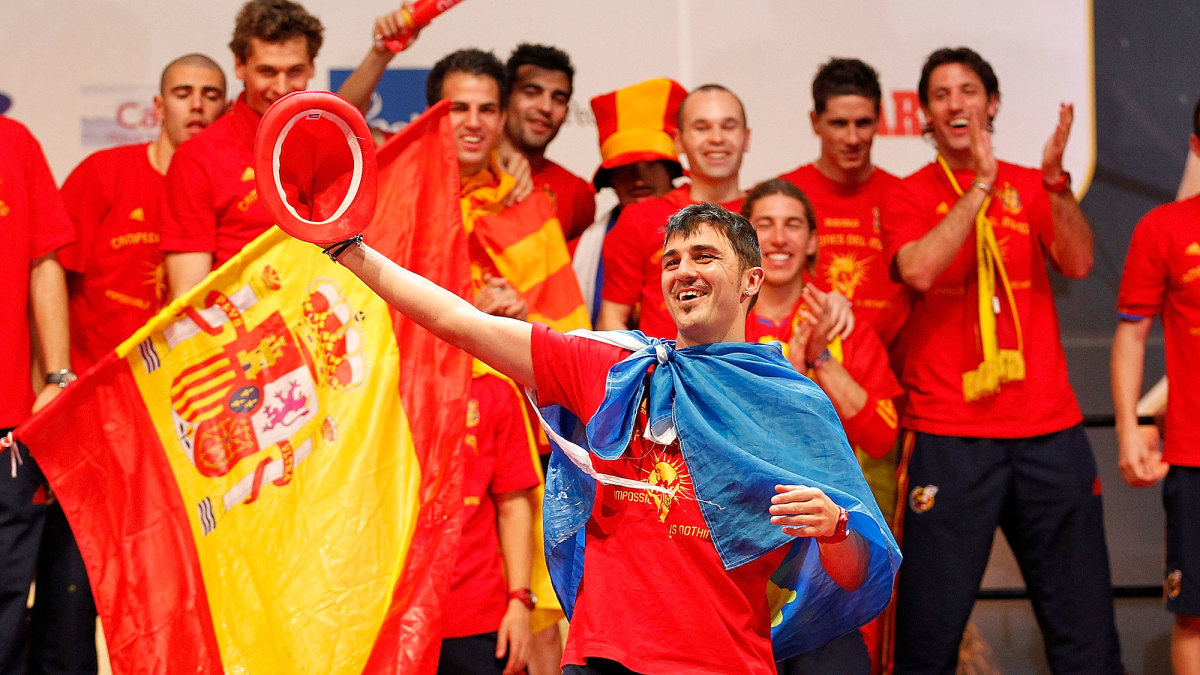The Legacy of Spain's 2010 World Cup Title, a Decade Later
This story is part of our series looking back on the 2010 World Cup and its biggest moments and themes with a decade's worth of perspective. For more, read about the lasting legacy of the competition in South Africa; the long-tail impact of Frank Lampard's ghost goal vs. Germany; how France's debacle planted the seeds for its 2018 success; whether Luis Suarez's controversial handball was really all that evil, and how Argentina set the template for a decade of disappointment.
The players, competitions and cities changed—London, Milan, Madrid—but the obstacle so frequently was the same. For years, wherever José Mourinho managed, Barcelona was bound to be in the way. And to beat the Blaugrana, he’d have to solve tiki-taka, the beguiling, infuriating approach to possession and pressure that powered Barcelona and Spain to titles.
After a while, Mourinho developed a counter approach of his own. It was detailed in The Special One, a biography by Spanish writer Diego Torres, and it included conclusions like:
—“The game is won by the team who commits fewer errors.”
—“Whoever has the ball is more likely to make a mistake.”
—“Whoever has the ball has fear,” and “Whoever does not have it is thereby stronger.”
There’s some truth there within the cynicism. Passing, moving and receiving is difficult, and every touch, feint, and run sets the table for a mistake. To minimize those mistakes would require players of exceptional ability who are comfortable with the ball at any spot on the field, along with the time required to commit those patterns of play to something resembling muscle memory. Sometimes Mourinho won and sometimes he lost, but there was a reason tiki-taka took soccer by storm in the mid-to-late 2000s. It was effective. It was groundbreaking. And the degree of difficulty was off the charts.
Barcelona as tiki-taka’s birthplace made sense. It’s the club of Cruyff and Guardiola, and it’s a place that prides itself in going against the grain. But for the Spanish national team to embrace it so emphatically is more surprising, and not only because it created a temporary imbalance in the Barça-Real Madrid duopoly. International soccer isn’t club soccer. The timing and chemistry required to make tiki-taka work are so much harder to generate for national teams, which train together only intermittently. So the advantage in a month-long all-star tournament—that’s effectively what the World Cup and continental championships are—frequently tilted toward sides that were talented, but well-drilled, basic and mistake-free. Tiki-taka just complicated matters.
And that’s why the Spain of 2008-2012 will never be forgotten, and why the team that won the World Cup in South Africa 10 years ago—even though it lost its opener to Switzerland, didn’t score many goals and suffered at times during the knockout stage—will be considered an iconic champion for as long as the sport is played. This new brand of La Furia Roja not only changed the game, it demonstrated that at a modern World Cup, high-level complexity, innovation and success didn’t have to be mutually exclusive.
A decade later, it’s not only what that Spanish side won that’s a source of pride (two Euros and the World Cup), it’s how they did it.

“We created a different style,” said forward David Villa, who scored five of Spain’s eight goals en route to the 2010 title. “The other years in Spain, before this team, we always played a lot of physical players. We never won anything and then we changed the history in our country. It showed the people that with a lot of quality and style and different types of players, you can win also.”
The “Furia” in the national team’s nickname was inspired by that formerly robust approach. But as Villa said, it bore minimal fruit. Spain was an established soccer power, but before 2008, it had one European title (1964), an Olympic gold medal (1992) and just one World Cup semifinal berth (1950) to show for it. Then the stars aligned, as coaches like Pep Guardiola and Luis Aragonés saw the potential of the smaller, more skillful players coming out of Barcelona like Xavi Hernández and Andrés Iniesta, and married that to the promotion of defensive midfielders and center backs who had an attacker’s touch.
“We arrived in the perfect moment. We had coaches that were creating and believing in that style. We had players who played in that style,” Villa told Sports Illustrated from his home in Madrid. “The style was to have the ball for the majority of the time possible, to not lose the ball. We don’t have to rush to arrive to the goal. We try to create the play without a rush. No long balls. Keep the ball every time. Pass the ball between the midfielders until you arrive.”
Tiki-taka required technique, discipline and focus, especially since opponents would pack the defensive third of the field in order to stop it, which, at the international level, could keep scores low. And a mistake would turn the game on its head. Spain walked that tightrope in South Africa, winning each of its four knockout-round games by 1-0 margins. The earliest of those winning goals didn’t come until the 63rd minute. That’ll probably never happen again.

The “perfect moment” Villa described passed at the 2013 Confederations Cup, where an athletic and robust Brazilian team blasted Spain, 3-0, in the final. La Roja exited the 2014 World Cup after the group stage, lost a Euro 2016 round-of-16 match to Italy and then, at the same point in Russia, played the game that many said marked the death of tiki-taka. Over 120 minutes against Russia in the second round, Spain completed a World Cup-record 1,137 passes. The hosts managed a meager 285, and naturally wound up winning on penalties. Xavi and Villa were gone, Iniesta was on his way out, and the result demonstrated just how fragile tiki-taka could be.
“We played at a level and with a style that nobody had done before. We won three major tournaments back-to-back,” Spain manager Fernando Hierro said following the defeat. “But now we are in 2018, and many things have changed. Now we see that people are playing with a [back] line of five, which we thought had been forgotten. There are also a lot of direct balls and quick transitions. So everything is changing. Trends change.”
Indeed they do. But identity doesn’t have to, Villa said. Tiki-taka may evolve, as it did under Guardiola in Munich and Manchester, and as it must with the Spanish national team absent Xavi, Iniesta and the rest. But the commitment to dictating and defending via possession, and to developing players with elite technique at all positions, probably will remain Spanish hallmarks.
“It’s difficult to win. It’s not easy. I think we played much better than Russia but that day, we didn’t have the luck to win. … And in the [2010] World Cup, we lose against Switzerland and we create like 35 chances and Switzerland creates just one chance. That is football,” Villa said.
“We create a style. We have the players, and we should win,” he continued. “In South Africa, we didn’t change anything. We didn’t care about what the people said [after the opener]. We watched the game again. We saw we were better than Switzerland, that we had a lot of chances. We played the same way against other teams and we won. We continued to play the same way. We believe a lot in our style.”

Spain’s identity was sealed in South Africa, and the rest of the world was challenged. Germany, its core influenced in part by Guardiola’s early work at Bayern, accepted that mantle in 2014. World Cups can be won with the ball, by playing out of the back, by interchanging positions, and by players filling complex, multi-dimensional roles. Find a style and a core, and stick with it. You don’t need to be passive, conservative or blessed with Diego Maradona circa 1986 to win a modern World Cup. That is Spain’s legacy.
Tiki-taka isn’t for everyone, obviously. Most of the youth coaches who promised in 2010-11 to play like Spain/Barcelona probably thought better of it at some point. A commitment to the style has to include the players who can learn to pull it off. And Villa is well aware that those players aren’t exactly overflowing at the USL Championship level, which is where he plans to launch his New York City club, Queensboro FC. It was scheduled to take the field in 2021, but that was before the coronavirus pandemic wreaked havoc on the sports world.
Villa said he wants the on-field product to be the result of a collaborative effort with his QBFC staff and soon-to-be-named manager. And he’s comfortable with several styles of play. His years with Spain and Barcelona comprised only a part of his career, which also included spells at Valencia, Atlético Madrid and New York City FC, among others. But a decade later, the rush of unleashing a new kind of soccer on the world, and winning the sport’s biggest prize, still lingers. He knows he’ll always be linked to it.
“It’s difficult to say [Queensboro] will play like that. We are working on it, and we are 100% trying to create a great team that the people will be very proud of when they come to the stadium,” he said. “I don’t want to copy anything. We want to create our own style. We don’t want to say in the beginning, ‘We will be a Barcelona team or an Atlético team, or we’ll be a Guardiola team or a Mourinho team or a David Villa team.’ We want to be Queensboro FC.
“But if you ask me a style, obviously it will not be a style that I put a No. 9 with two meters size and put the ball from the keeper to the No. 9, and the No. 9 tries to score,” Villa continued. “Obviously that is not my style and everybody knows.”
